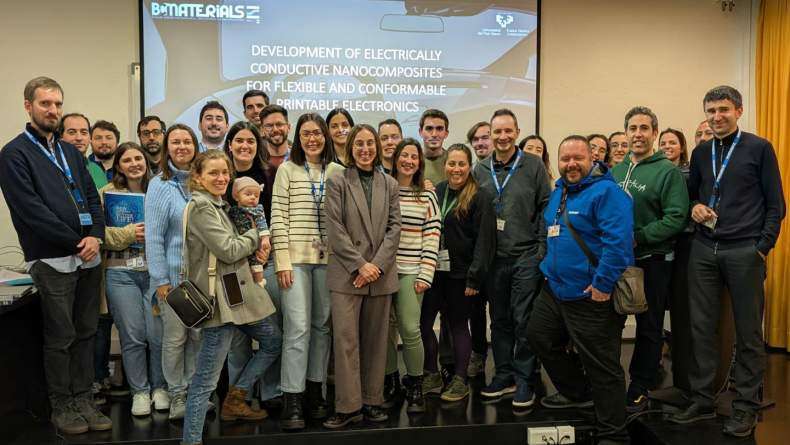Fortnightly seminar online by Ruben Teijido & Mikel Rincon

Current trends on layered inorganic-polymer nanocomposite coatings for anticorrosion applications: identification of problems and proposed strategies to solve them
The fight against corrosion problematic is growing stronger each day due to an ever-increasing demand for using marine environments and its resources. The development and manufacture of advanced hybrid polymer-inorganic layered anti-corrosion coatings is a trending topic focusing a fair amount of scientific interest. The application of barrier-type coatings, in which inorganic 2D fillers together with a properly structured polymeric matrix, act by elongating the diffusion pathways of corrosive species, thus slowing the whole process, is one of the main strategies. Several polymeric materials and inorganic fillers may be of use when constructing these kinds of protection systems. At this regard, some of the most recent publications focus on the use of more eco-friendly materials, prioritizing in biodegradable polymers, both synthetic or biopolymeric, and natural inorganic 2D materials as clays, layered double hydroxides or more recently graphene and its derivatives. At this regard, I will present you with some of the main problems and drawbacks that one can encounter when designing such systems. First, the tendency of graphene and its derivatives to agglomerate, thus dispersing inhomogeneously and losing active surface area and efficiency as barriers. Second, the water affinity that most biodegradable polymers present, producing swelling behaviors that need to be restricted and controlled in order to diminish the diffusion of water and water-soluble species through the final material. Finally, the proposed strategies as initial solutions to deal with both these problems and the future work that will be performed following this research line will be presented.
Multiresponsive Smart Hydrogels Based on Core-shell Anisotropic Nanoparticles
Responsive hydrogels that respond to a broad range of stimuli are of interest for soft electronics, biological applications, sensors and actuators. In this ongoing work, smart composite materials based on agarose hydrogels and hybrid nanoparticles of Au:Fe3O4 with a core-shell nanorod (NR) morphological structure have been developed. The high aspect ratio of the anisotropic nanostructures enables magnetic manipulation, orientation and assembly of NRs inside a matrix. Furthermore, new functionalities coming from the Au-coated shell can provide a new range of nanoscale related properties with macroscopic anisotropy. Properties such as optical, electronic, etc. opens the path to a new area of research and applications.
Here, the fabrication of these complex hydrogels and the analysis of their characteristics is shown. The synthesis mechanism involves a multistep method by the creation of several hybrid nanostructures with a varying range of morphologies, optical and magnetic properties, and the incorporation and assembly in hydrogels. First, the synthesis of Fe3O4 NRs of different sizes based on solvothermal method was carried out. Then, NRs surface was modified through a silanization / ligand-exchange process to provide a highly charged surface and water solubility. 2-3 nm negatively charge Au nanoclusters, which are selective for amine groups, were employed to create intermediate structures of core-satellites type. These core-satellites structures were used for Au-coating by a seed-mediated-growth process. Preliminary results show that these hybrid nanoparticles can be used to generate directional assembly inside an agarose based hydrogel providing anisotropic magnetic and optical features.
The seminar will be online due to COVID restrictions.
https://teams.microsoft.com/l/meetup-join/19%3ameeting_YTM2MjJjMmUtYzBmZS00ZWQ2LWJiMjEtZjAxMjZhYmZkNWQ5%40thread.v2/0?context=%7b%22Tid%22%3a%222f54ab68-83af-4d70-8895-a0d1e95ec899%22%2c%22Oid%22%3a%227778b4e1-e06d-485b-b530-cf013d4e9498%22%2c%22IsBroadcastMeeting%22%3atrue%7d
Related news
Reunión del nuevo Patronato de BCMaterials
El pasado 1 de abril tuvo lugar la reunión del nuevo Patronato de BCMaterials. En dicha reunión se hizo un repaso a la situación general del centro y se examinaron los resultados y actividades...Track the Twin: gemelos digitales para mejorar los puntos cuánticos
La red doctoral Marie Curie ‘Track The Twin’, en la que participa BCMaterials, ya está en marcha. Este proyecto busca mejorar el rendimiento a lo largo del tiempo de los puntos cuánticos a través de...Maibelin Rosales, en la Tabla Periódica de Científicas Chilenas
Queremos felicitar a nuestra investigadora post-doctoral Marie Curie, Maibelin Rosales, por haber sido seleccionada como una de las 118 investigadoras reconocidas en la Tabla Periódica de Mujeres...Esraa Sewlam y Lía Campos, nuevas doctoras de BCMaterials
Queremos dar nuestra más sincera enhorabuena a las investigadoras pre-doctorales Esraa Sewlam y Lía Campos Arias por haber obtenido su título de doctoras en Ciencia y Tecnología de Materiales por la...



